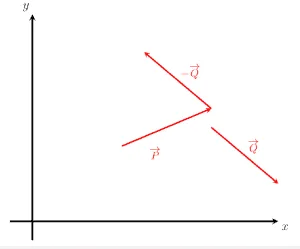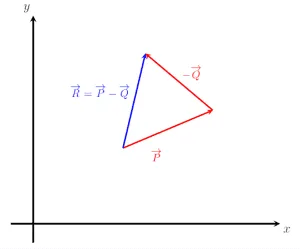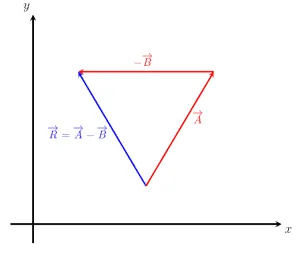- Home
- >
- Vector Subtraction – Explanation and Examples
Vector Subtraction – Explanation & Examples
 There are many parallels between scalars and vectors, and vector subtraction is no exception. Specifically, vector subtraction is:
There are many parallels between scalars and vectors, and vector subtraction is no exception. Specifically, vector subtraction is:
“The addition of a vector with the negative of another vector.”
From the above definition, it is clear that vector subtraction merely means the addition of negative vectors. Before learning vector subtraction, therefore, it is important to review negative vectors.
As we know, a negative vector is obtained by multiplying a given vector by -1. This reverses the direction of the vector.
Let’s say A is a vector pointing from left to right. Multiplying the vector A by -1 gives us -A, which is the vector A’s negative. Although the magnitude of the two vectors A and –A will remain the same, the negative vector –A will point from right to left.
In this topic, we will further discuss the following aspects of vector subtraction:
- How to Subtract Vectors
- Subtracting Vectors Graphically
How to Subtract Vectors
We know that two vectors, A and B, can be added together using vector addition, and the resultant vector can be written as R = A + B. Similarly, if we want the subtraction of two vectors, A and B is expressed mathematically as:
R = A – B
Alternatively as:
R = A +(- B)
Thus, subtracting the two vectors is the same as adding vector A and vector B’s negative (i.e., B). The vectors B and –B will have the same magnitude, but -B’s direction will be opposite to that of vector B.
Vector subtraction also works when the two vectors are given in component form or as column vectors. If A = (ax1, ay1) and B = (bx1, by1), then the difference between the two is:
R = A – B
Where the horizontal and vertical components of the resultant vector R can be expressed as:
Rx = ax1 – bx1
and
Ry = ay1 – by1.
Thus, the resultant vector can be computed by simply computing the difference of the two original vectors’ respective horizontal and vertical components.
Subtracting Vectors Graphically
Graphically, the head-to-tail rule used in vector addition can be adapted for vector subtraction. For example, consider the two vectors P and Q as shown in the image below. Note that the vector –Q is obtained by reversing the direction of Q.

Next, we add the vectors P and –Q using the head-to-tail rule as follows:
First, draw the vector P, and then place the vector –Q so that its tail is connected to the head of vector P. Now, to find the sum of P and –Q, draw the resultant vector R such that it connects the tail of vector P to the head of the vector –Q as shown in the image below.
Mathematically, the resultant vector can be expressed as:
R = P – Q

Examples
In this section, we will practice vector subtraction with different examples and their step-by-step solutions using the different methods as discussed above.
Example 1
Graphically subtract the given vectors A and B shown in the image below by using the head-to-tail method.

Solution
We first draw the negative of vector B by reversing its direction, i.e., -B. Next, we add the vectors A and –B by applying the head-to-tail method.
We first place the given vectors A and –B such that the tail of the vector -B connects to the head of the vector A as shown in the image below. Next, to find their sum, we draw a resultant vector R such that it connects the tail of vector A to the head of vector –B. Mathematically, the resultant can be expressed as:
R = A + (-B)

Example 2
Given two vectors AB = (3, 2) and BC = (2, 2), algebraically subtract the two vectors. Then, determine the magnitude and the angle of the resultant vector given as:
S = AB + (-BC)
Solution
First, determine the negative of vector BC by multiplying it by -1:
-BC = (-2, -2).
Next, to find the resultant vector S, we add the vectors AB and –BC as follows:
S = AB + (- BC)
S = (3 , 2) + (-2, -2)
S = (1, 0).
The magnitude of the resultant vector S can be found using the following equations:
|S| = √ (Sx) ^ 2 + (Sy )^2
|S| = √ (1) ^ 2 + (0)^2
|S| = √ 1
|S| = 1 unit
The angle of the resultant vector S can be then found as follows:
Φ = tan-1 (Sy/ Sx)
Φ = tan-1 (0/1)
Φ = tan-1 (0)
Φ = 0 degrees
Example 3
Given the two vectors S = 10 m, Φ = 30 degrees and T = 20m, Φ = 60 degrees. Subtract the two vectors, then calculate the magnitude and the angle of the resultant vector using the component method.
Solution
Let R be the resultant vector equal to the sum of the given vectors S and – T. It can be expressed as:
R = S + (-T)
To use the component method, we first break down the given vectors into their respective horizontal and vertical components:
Sx = S Cos Φ
Sx = 10 Cos 30
Sx = 8.660 m (Approximately)
Similarly, for the vertical component:
Sy = S Sin Φ
Sy = 10 Sin 30
Sy = 5 m
Next, we compute the components of vector T:
Tx = T Cos Φ
Ty = T Sin Φ
Where,
Tx = 20 Cos 60
Tx = 10m
Ty = 20 Sin 60
Ty = 17.320 (Approximately)
Now, we can compute the difference vector by computing the difference of the individual x and y components of the S and –T vector as:
Rx = Sx + (-Tx)
Rx = 8.660 + (-10)
Rx = -1.34 m
Ry = Sy + (-Ty)
Ry = 5 + (-17.32)
Ry = -12.32 m
The resultant vector R can be expressed as the column vector:
R = (-1.34, -12.32).
Finally, the magnitude and the angle of the resultant vector are:
|R| = √ (-1.34) ^ 2 + (-12.32)^2
|R| = 12.392 m
Φ = tan-1 (Ry/Rx)
Φ = tan-1 (-12.32/-1.34)
Φ = 83.79 degrees (Approximately)
Thus, the resultant sum vector can be expressed as:
R = 12.392 m, Φ = 83.79 degrees
Example 4
Determine the resultant sum vector for the two vectors A = (-5, -1) and –B = (2,-1).
Solution
The given vectors are already in their component forms, so we first determine their angles.
For the vector A:
Φ = tan-1 (Ay/Ax)
Φ = tan-1 (-1/-5)
Φ = 11.309 degrees
For the vector –B:
Φ = tan-1 (By/Bx)
Φ = tan-1 (-1/2)
Φ = -26.56 degrees
Next, we find the resultant vector by adding the individual components:
S = A + (-B)
Sx = Ax + (-Bx)
Sx = -5 + 2
Sx = -3
Sy = Ay + (-By)
Sy = -1 -1
Sy = -2
The resultant vector S can be expressed as the column vector:
S = (-3, -2).
Finally, the magnitude and the angle of the resultant vector are:
|S| = √ (-3) ^ 2 + (-2)^2
|S| = 3.605 units
Φ = tan-1 (Sy/Sx)
Φ = tan-1 (-2/-3)
Φ = 33.69 degrees
Thus, the resultant sum vector can be expressed as:
S = 3.605 units, Φ = 33.69 degrees
Example 5
Given the three vectors A = (-20, -1), X = (5,-4), and Y = (2,6), determine the vector Z = A – X –Y.
Solution
Z = A – X –Y
Z = (-20, -1) – (5, -4) – (2, 6)
Z = (-20-5-2, -1+4-6)
Z = (-27 , -3)
Practice Questions
- Given two vectors V = (2, 5) and C = (3, -2), determine A = V– C . Then, determine the magnitude and the angle of the resultant vector A.
- Given two vectors G = (5, 5) and –H = (4, -10), determine their sum using the head-to-tail rule. Then, determine the magnitude and the angle of the resultant vector P = G – H.
- Consider the vector OA, where O = (-1, 3) and A = (5,2), and the vector UV, where U = (1, -2) and V = (-2, 2). Subtract the two vectors, then give the magnitude and the angle of the resultant vector S.
M = 10 m straight east and N = 15 m straight north. Subtract the two vectors, and then give the magnitude and angle of the resultant vector.
- Given two vectors A = (10, 2, 5), and M = (5, 0, -4 ), determine the vector B = M – A.
Answers
- The resultant vector A is A = (-1, 7), the magnitude of A is |A| = 7.079 units (approximately), and the angle is Φ = -81.86 degrees.
- The resultant vector P is: P = (9, -5), the magnitude of P is |P| = 10. 30 units (approximately), and the angle is Φ = -29.05 degrees.
- The vectors are OA = (6, -1) and –UV = (3, -4), the resultant vector S is S = (9, -5), the magnitude of S is |S| = 10. 30 units (approximately), and the angle is Φ = -29.05 degrees.
- The resultant of the two vectors is:
R = M + (-N)
|R| = 18.027 m (Approximately)
And the angle is:
Φ = tan-1 (15/10)
Φ = 56.30 degrees
Thus, the resultant vector R is R = 18.027 m, Φ = 56.30 degrees to the Northeast.
B = M– A
B = (10, 2, 5) – (5, 0, -4 )
B = (10-5, 2-0, 5+4)
B = (5, 2, 9)
Previous Lesson | Main Page | Next Lesson
